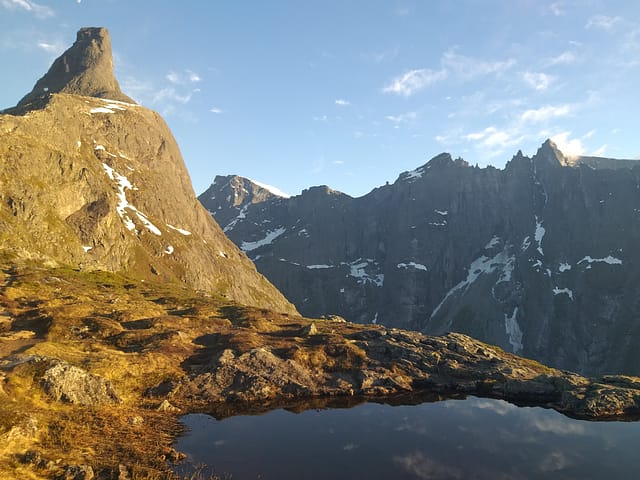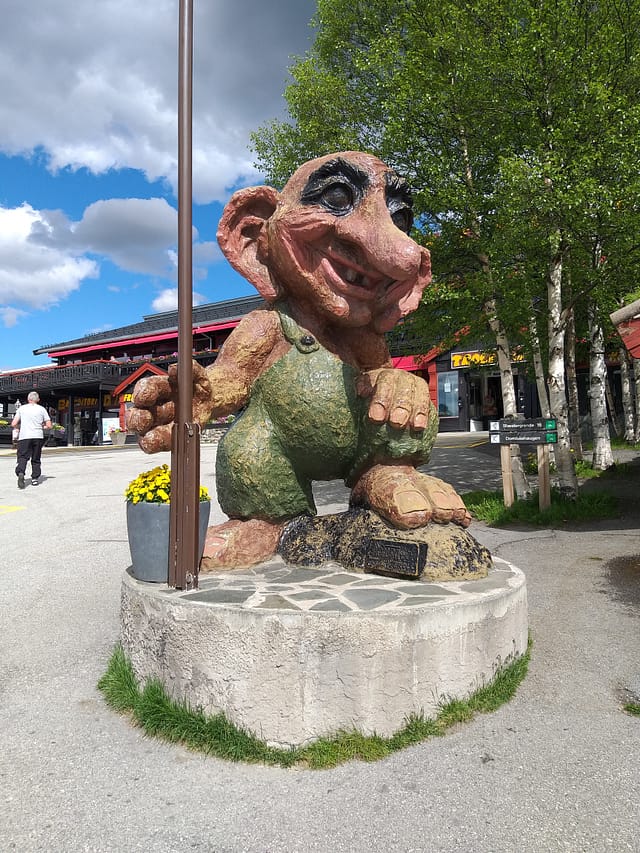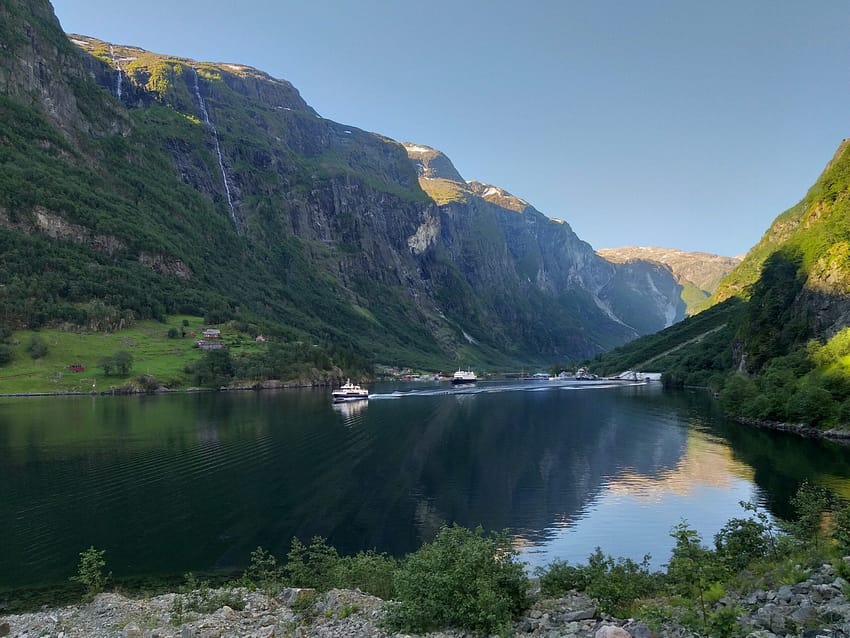Norway in summertime is a road-tripping paradise. Not only are the roads are wide, smooth and quiet, but the roadside scenery is astonishing and the daylight hours are near never-ending.
I took a week road trip in Norway and even though I’m not confident driving on the other side of the road elsewhere (in Australia we drive on the left), I felt comfortable with the challenge in Norway.
I did a lot of research beforehand, and if I do say so myself, I think I created a pretty neat Norway road trip itinerary.
An account of my Norway road trip is provided below.
Fast Facts on Norway:
- Norway is home to Europe’s six highest waterfalls, raging rivers, snowy peaks and 400,000 lakes. Therefore it’s no surprise that around 98% of Norway’s power comes from hydroelectric sources.
- Parts of Norway are truly wild and Norwegians have a close connection with nature. Europe’s biggest herd of wild reindeer lives here and polar bears roam it’s arctic regions. Even the Colonel-in-Chief of the Norwegian King’s Guard is a penguin.
- Norway is known for its stunning fjords and there are 1,190 of them in the country.
- Over two thirds of Norway is mountainous and there are over 300 mountain peaks.
- No-one knows how long Norway’s coastline is. It has over 200,000 islands and such an intricate shoreline no one has measured it.
- In a large portion of Norway, the sun never sets in summertime. That also means in winter, the sun never rises.
- Skiing was invented in Norway.
- While sushi is Japanese, Norway came up with the idea of using salmon in it.
- Norway was the first nation to criminalise discrimination against gay and lesbian people, they have some of the world’s most humane jails and some of the lowest reincarceration rates in the world. Everyone in the country’s annual income, tax paid and total wealth is recorded and can be looked up by anyone else.
- Advertising aimed at children under 12 is illegal in Norway. However, whaling is not.

Itinerary
Our Norway roadtrip itinerary was as follows:
- Day 1: Oslo to Åndalsnes (5 hours, 45 mins – 440 kms)
- Day 2: Åndalsnes to Styrn via Geiranger Fjord (4 hours, 40 mins including ferries – 172 kms)
- Day 3: Stryn
- Day 4: Stryn to Gudvagen (4 hours – 227 kms)
- Day 5: Gudvagen to north of Stavanger (4 hours, 30 mins – 270 kms)
- Day 6: North of Stavanger to Stavanger (1 hour, 20 mins – 55 kms)
- Day 7: Stavanger
Getting There
We flew in late at night from Montenegro to Oslo, Norway, picked up our (rather nice!) hire car and drove straight to our basic but comfortable hotel, Oslo Airport Motel to sleep.
We arrived at the hotel at 11pm and we had a lot of trouble getting someone’s attention to let us in to check in, but after over half an hour, we finally got inside.
Day 1 – Oslo to Åndalsnes
In the morning we left from our hotel just outside Oslo and embarked on our first drive through Norway, to the west coast town of Åndalsnes. The first part of the drive was fairly uneventful, especially as the car we had hired was a fancy volvo v90 luxury sedan that basically drove itself. In Norway, the speed limit never gets over 80 km/h, so drives take a long time. Luckily, the scenery is wonderful, so you don’t want to rush anyway.
For lunch, we stopped at McDonalds (so Norwegian) and later stopped at a small grocery store to grab some supplies for dinner. Outside the grocery store, we saw our first Norwegian Troll, as you can see below. Norwegians are totally obsessed with trolls and it feels like every second landmark is named after them. My travel companion absolutely hated it, and particularly hated that the trolls were so ugly, which made me find all the troll themed everything hilarious.

As we travelled, the drive became increasingly impressive. Huge waterfalls descended down towering cliffs as we moved westwards. The sheer amount of water in the rivers and falls that we drove past was astonishing. We stopped at a couple of places to take in the view.




In the evening we reached Trollstigen Camping, our destination for the night. We checked in to our accommodation, which was a pre-booked ‘sod-roofed’ cabin, complete with a green grass roof. These plant covered cabins are super cute and traditionally Scandinavian. In fact, green roofs have been in a thing in Norway for thousands of years.
Norway is super expensive, and staying in self-contained cabins is also one of the cheapest ways to travel around the countryside, aside from wild camping (which is allowed).
When we stayed in cabins, it was the job of guests to sweep them and give them a quick clean at the end of your stay to avoid a significant cleaning fee. It was a pretty seamless system and definitely saved us some cash over booking nights in traditional hotels.
The views around our cabin at Trollstigen Camping were amazing. It was mind-boggling to see how light it was even late into the evening and following dinner, we headed out for a hike nearby. We started this hike at 9.15 pm and didn’t finish until 11.40pm and it was still light. I love Norwegian summer!
From the hike, we could look across to the famous Trollveggen (aka “Troll wall”).






Day 2 – Åndalsnes to Stryn via Gerainger Fjord
The next morning we kicked off our day of road-tripping with the twisty turns up the famous Trollstiggen, a.k.a Troll’s path. We stopped at the bottom, part way up and at the top for photos. The viewing centre at the top was a great place to stretch our legs. Then we made our way towards Geiranger Fjord. Along the way we stopped at Gudbrandsjuvet gorge.







Geiranger Fjord
Geiranger Fjord was gorgeous on the day we visited, with blue and sunny skies. We spent some time wondering around town of Geiranger, and took the circiut walk around the raging blue river that runs through town and into the fjord. After around an hour and a half in town, we boarded the car ferry from Geiranger to Hellesylt. The ferry ride took about an hour and a half and provided wonderful views of the fjord.
From there we headed to our accommodation in red fjordside wooden cabins in the quiet little village of Olden, Stryn.





That evening, we took a drive into the hills after dinner and stopped to explore more waterfalls, the stunning plateau and almost drove all the way back to Geiranger via the inland route. We could actually see the Geiranger fjord in the distance before we turned around. The roads were empty late at night and we had expansive, snow scattered, mountainous scenery all to ourselves. It was spectacular and so quiet it was somewhat eerie as well. It’s so hard to put yourself to bed and not stay out sightseeing when the sun never sets!
Day 3 – Exploring around Stryn
We had the luxury of two nights in our waterside cabin in Stryn, so on our third day of our Norwegian adventure, we spent the day exploring the local area. In the morning we visited Brikdalsbreen Glacier, which was an easy walk with great scenery, rainbows, waterfalls, gorges and a glacier, as well as a cute cafe at the walk’s entrance. We headed on to Loen for the afternoon and read about the historic landslides in the area on an interpretive trail, while taking in the beautiful fjord scenery around us. The weather was warm and sunny all day long.



Day 4 – Stryn to Gudvagen
On Day 4 of our Norway road trip, we travelled 3 and a half hours from Stryn to Gudvagen, which lies at the end of Naerfjord, one of Norway’s most famous fjords for visitors after Geirganger Fjord. Along the way, we stopped in at Boyabreen glacier, which can be seen from the road, and we also drove through Lærdal tunnel, which at 24.5km is the world’s longest road tunnel. Gudvagen was a lot quieter than Geiranger, and the tourist elements are largely focussed around one hotel and restaurant at the fjord’s end. We checked it out in the evening and then had an earlyish night.




Day 5 – Gudvagen to North of Stavanger
In the morning of day 5 of our Norway road trip I took a solo stroll up the side of Naeryfjord before we headed on our way southwards. Our first stop of the morning was Stalheim Hotel for a coffee stop and to take in its famous view. It was a great place to explore and had military ruins and a great collection of historic items inside.

Awakened and refreshed from our morning coffee, we headed onwards towards the town of Voss via the gorgeous waterfall Tvindefossen, where we took some pictures and laid about on the grass in the sun.

After grabbing some lunch supplies in Voss, we brainstormed a place we could eat a picnic. We didn’t have an idea in mind, so we googled ‘waterfall’ in google maps and it said that there was one with a toilet and small picnic area on a side road coming up. It wasn’t particularly sign posted so we kept our expectations low. What we stumbled on was definitely a great spot for lunch. You can see just how much the waterfall dwarfed me in the photo below, as well as the fancy toilets.


The next part of our drive was gorgeous, as we headed down towards Odda and further south towards Stavanger. The scenery was still mountainous, but rather than being filled with wilderness plateaus and forests as it had up north, there were fruit orchards lining the fjords and an increasing number of summer houses dotted along the shorelines of the various bays we passed along the way.
This was, however, perhaps the most stressful part of our trip, as it was the one night we hadn’t booked accommodation and our options were slim. We pulled into a couple of camping / cabin sites that had no vacancy, and I googled potential leads for a place to stay as my travel buddy drove along.
Finally, not too far north of Stavanger, we found a campsite with cabin vacancy for the night.
My poor travel mate was by then suffering from a bad prawn sandwich for lunch that had come back to haunt him, so we had a quiet night in and ate pizza at the campground cafe. It was fine, but not particularly special, and I can’t even recall the name of the place we stayed at! My big tip for Norway would be to book your accommodation in advance, both to save money and to make sure you actually get a bed for the night.
Day 6 – North of Stavanger to Stavanger
Today we drove a short distance and across a bay (on a car ferry) to the coastal city of Stavanger, where we had the good fortune of hospitable friends to stay with. Our host took me on a walk to a nearby community garden, which was immaculate and very Scandinavian, tidy and well organised, and we chatted about Norweigan culture.
We explored the town and went down to the waterfront for a drink before having a lovely dinner at a local restaurant called Sol, that focused on local fresh ingredients and Scandinavian flavours. Everything was delicious and the service was fantastic.


Day 7 – Stavanger
Today we went sightseeing around Stavanger on foot. We also planned to walk to Pulpit Rock for our last night in Norway but our plans were foiled by unworkable ferry times. Still, the city itself was lovely to walk around, with streets of colourful houses and a great Norweigan Petroleum Museum (more interesting than in sounds) and the Museum of Archaeology, that had an interesting collection of viking swords, buckles and other items. Instead of Pulpit Rock, we took a walk in the nearby countryside in the evening with our hosts at a different local walking area. It was a lovely final day in Norway before we flew to Sweden early the next morning.


Tips for a Norway Road Trip:
- Plan to have some two night stops in your trip so you can rest a little bit and break things up.
- Don’t plan days of more than 5 hours driving, and have some days that include less driving.
- Check whether the roads you plan to travel on are open or not in the month you visit (some roads close in winter and shoulder months due to snow and ice).
- Make sure you know ferry times in advance, to avoid either getting stranded somewhere or having to endure long waits.
- That said, if you go in summer, you can drive fairly long days and never worry about running out of sunlight
- Don’t be a leadfoot – speed limits are slow and strict in Norway. This makes for great sightseeing as you don’t feel like you’re slowing everyone down whilst driving as a tourist.
- Everything is expensive, including takeaway food and alcohol. Check prices before you buy anything and consider shopping from grocery stores and having picnics to save money.
- Don’t worry about not speaking Norwegian if you speak English, as English is spoken nearly everywhere.

I absolutely swooned throughout this whole post. Norway completely captured my heart when I travelled there in 2019 and I am dying to return- a road trip in the summer months sounds like a dreamy way to experience more of the scenery and charming towns. Loved your Norway facts at the beginning of the post as well!😊💖